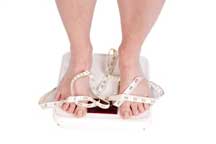 Beware Of That Torturous Device Lurking In A Corner of Your Bathroom
Beware Of That Torturous Device Lurking In A Corner of Your Bathroom
Do you own a set of dusty, antiquated bathroom scales with a simple needle and dial that allows for a certain amount of optimistic user error? Or maybe you’ve invested in a bells and whistles body composition monitor, complete with WiFi that sends your precise measurements directly to an app on your iphone? Whatever the level of technology, you’re more than likely to have some sort of weight measuring machine tucked away somewhere.
However, no matter how much money you’ve spent on them, bathroom scales are often fickle contraptions that can leave you feeling either deeply offended or over-the-moon, depending on the numbers that they reveal. If this sounds all too familiar, then beware, those numbers are often paint a confusing picture.
The Naked Truth
Surprisingly, when most people glumly stare down at the scales, they don’t account for the actual weight of any food or drink that they’ve recently devoured. It sounds obvious, but the heaviness of whatever you’ve consumed will be included in your recorded weight, as if you were holding it all in your hands, until you eventually excrete it from your body. The same goes for any clothes that you’re wearing.
For women, different times of the month can make you feel bloated and your jeans more of a struggle to do up, even if you have been angelic with your food and exercise regime over the previous few weeks. The best way to manage this is to acknowledge the fact that you may go up and down 3 to 4 pounds throughout your cycle. Learn what your personal levels of fluctuation are over time, and stay positive, as commiserating with chocolate every month certainly won’t help the cause!
Free Yourself From The Daily Insults
If you’re one of those people who regimentally jumps on the scales every morning, then you’re likely to set yourself up for failure at least once a week.
However, just because you’ve put a pound on in the last 24 hours, it doesn’t mean that your weight loss programme is a complete disaster and that you should wave the white flag, giving it all up for a large slice of cake. It’s just a natural blip, and, as your weight goes up and down all the time, you should be back on track in a day or so.
It’s more sensible, however, to weigh yourself on a weekly basis. Plot this figure on a graph, so that you can smooth out any fluctuations, and then look at your monthly moving average. You could also print the graph off and stick it on your fridge to keep you focused. It might all sound a bit nerdy, but at least you’ll be a healthy and slim-looking nerd!
As a guide for weight loss, you’re looking for a general downward trend of 1 to 2 pounds per week. Anymore than this, and you’re likely to be losing muscle mass, and will probably put all of it back on again. Any less than this, and you could possibly be trying a bit harder!
A Balancing Act
The easiest way to do an accurate weigh-in is to get yourself on the scales first thing in the morning, in your birthday suit, before breakfast and after you’ve been to the toilet.
When planning your weigh-ins, it’s worth noting that mid-week assessments will typically give you more favourable results than on a Monday morning after an excessive weekend!
If you’re also measuring body composition (the percentage of body fat, muscle and water), you’re likely to be de-hydrated first thing in the morning, which will affect your readings. Although your actual amount of body fat will not change throughout the day, your overall body fat percentage will, as your water levels fluctuate. It’s therefore recommended to measure your body fat percentages in the early evening, before dinner, and when your body is fully hydrated. Don’t forget that your hydration levels are also affected by exercise, heat and alcohol (even if you can still read the numbers!).
Body fat levels change slowly over time, and so again, you need to be looking at the long-term trend. If you’re looking to loose weight, you should be aiming to drop around 1% to 2% of body fat each month.
If this all sounds complex, and you switched off a couple of paragraphs ago, the most important thing to remember is consistency. Do your best to duplicate your weigh-in conditions every time. This means the same time of day, what you’ve eaten and drunk, the amount of clothing, whether it’s pre or post work-out etc. Remember, the harder you train and the healthier you eat, the better the results.
Don’t Be a Slave to The Numbers
If you’re watching your weight, but are now put off by using bathroom scales, then there is another way.
My personal preference is how my clothes are fitting, my level of fitness, how much energy I have and how healthy, strong and lean I feel. Your own perceptions can be the most valuable tools to help you track your weight. A full-length mirror and trustworthy friends are also good sources of information!
If you prefer something more mathematical, you can also take body measurements with a tape measure and body fat callipers. Provided that they are used correctly, preferably by a trained professional, they will give highly accurate readings of your size and body fat. Although, be prepared to be prodded and poked a little!
The Bottom Line
Scales are useful tools for watching and controlling your weight over a period of time, however regular weigh-ins aren’t the only or necessarily best option, and there are many other ways of monitoring your health.
And finally, a word of warning about result fixing techniques, like putting the scales on a slope to achieve a favourable weight, or jumping on and off them as quickly as possible to limit the damage. It’s called cheating and we’ve seen it all before. If this sounds familiar, do give us a call, as we’ll certainly be able to help put you back on track again!
Heather
Weight Matters
Posted by Heather Waghorn.
